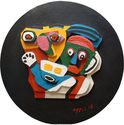
19th, 20th & 21st Century Fine Prints
707-546-7352 · fax 707-546-7924 · web: www.annexgalleries.com · email: artannex@aol.com
Christiaan Karel Appel Biography
Christiaan Karel Appel
Dutch
1921–2006
Biography
Christiaan Karel Appel, painter, sculptor, designer, and printmaker, was born in Amsterdam, the Netherlands on 25 April 1921. As a teenager, Appel apprenticed at his father's barber shop and it wasn't until his uncle, Karel Chevalier, gave him a box of oil paints that he began to pursue art at fifteen years of age. He first studied with his uncle but before long Chevalier realized his nephew had surpassed him. He took Appel to his own painting instructor, Jozef Verheijen, for training. Around this time Appel also created his first sculpture, though it would be some time before he returned to the medium.
After World War I, much of Europe attempted to return to the quietude of classical genres during the recovery ("La retour a l'ordre") but there were pockets of Avant-garde and other fringe movements that reacted against classicism. These movements soon bore more significance as the world's political spectrum became unstable. In 1939, Appel left his family home and moved into his own studio, rooming with the anarchist Henk Eikeboom.
As it became increasingly clear that Germany planned an occupation of the Netherlands, Appel attempted to enter into the Royal Academy of Fine Arts in Amsterdam. He knew a student status would allow him to stay out of the way of the Nazis despite his anarchistic leanings. His first attempt in 1941 failed so he began traveling throughout the countryside, sketching and keeping to himself. In 1942, he was accepted into the academy, where he studied Modernism and Surrealism as well as the poetry of Walt Whitman. His work from this time was greatly influenced by Pablo Picasso, Henri Matisse, and Jean Dubuffet, and he became close friends with the artist Corneille (Guillaume van Beverloo). In 1944, having completed his studies, Appel no longer had the protected status of a student; his artwork and lifestyle made him a target of Nazi suspicion. When accused of aiding Allied sympathizers, he went into hiding.
In 1945, Appel returned to Amsterdam and remained transient, staying and traveling with Corneille. He held his first solo exhibition at the Het Beerenhuis in Groningen and was a part of the Jonge Schilders (Young Painters) exhibit at the Stedelijk Museum in Amsterdam, alongside Corneille, Eugene Brands, and Anton Rooskens. Two years later he visited Paris for the first time, where he was exposed to the work of Edouard Pignon, Jean Dubuffet, and Constant, whose works deeply influenced Appel’s style. After returning home, he began working on three-dimensional works that included reliefs and sculptures made of found objects. By 1948, Appel’s reputation was expanding in the Netherlands and the collector Martin Visser invited Appel, Corneille, and Constant to show their works at the De Bijenkorf department store. Before long Appel began exhibiting regularly, and his painting “Sailor's Girl” was purchased by the Stedelijk Museum Amsterdam. Along with Corneille and Constant, Appel founded the experimental group and magazine Reflex, which soon thereafter merged with the CoBrA movement. It was in Paris, where he had an exhibition in 1949 and took up residence in 1950, that Appel truly mastered his creative powers. He worked freely with color, which he applied in thick blotches as a reaction against the geometric Academicism inherited from neoplasticism, and his subject matter was both broad-ranging and powerful.
CoBrA dissolved in 1951 after disagreements between the artists, and Appel began to associate with Abstract Expressionists including Jackson Pollack, Georges Mathieu, and Sam Francis. In 1953, James John Sweeney, then director of the Guggenheim Museum, visited Appel’s studio and purchased two of his paintings and selected his work for the Young European Painters exhibition later that year. In 1954, Appel won the UNESCO award at the 27th Venice Biennale, representing the Netherlands, and was given a solo exhibition in New York at the Martha Jackson Gallery.
In 1957, Apple traveled to the United States where he lived on Long Island for the summer. His exposure to American Abstract Expressionists artists, as well as jazz musicians and other luminaries, once again deeply affected his art, and he began working on polychrome sculptures, stained-glass windows, and mural paintings using explosive color and line. This led to a commission by UNESCO to paint a mural on the wall of its Paris headquarters' restaurant. (Rencontre du printemps now hangs in its conference room.)
Appel was prolifically active for the next four decades, exhibiting internationally. His oeuvre included theater and opera set designs and experimental films, and he received numerous commissions and awards. Among them was the Knight of the Second Degree, Commander of the Order of the Netherlands Lion award from the Dutch government and the French Legion d'Honneur, Officier status. In 1990 a retrospective of his work, entitled Ik wou dat ik een vogel (If I Were a Bird), opened at the Gemeentemuseum Den Haag and traveled to Germany, Spain, and Austria. That same year plans for the Karel Appel Foundation began and, in 2000, it was officially established in Amsterdam.
Karel Appel remained active until very near his death in Zurich on 3 May 2006. His last major exhibition took place in 2005 at the Gemeentemuseum and included new paintings of nudes highlighted by neon tubes.




